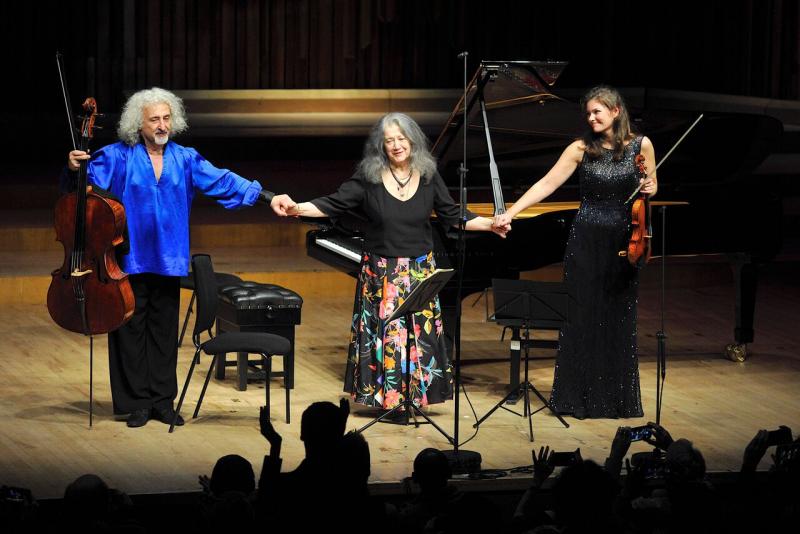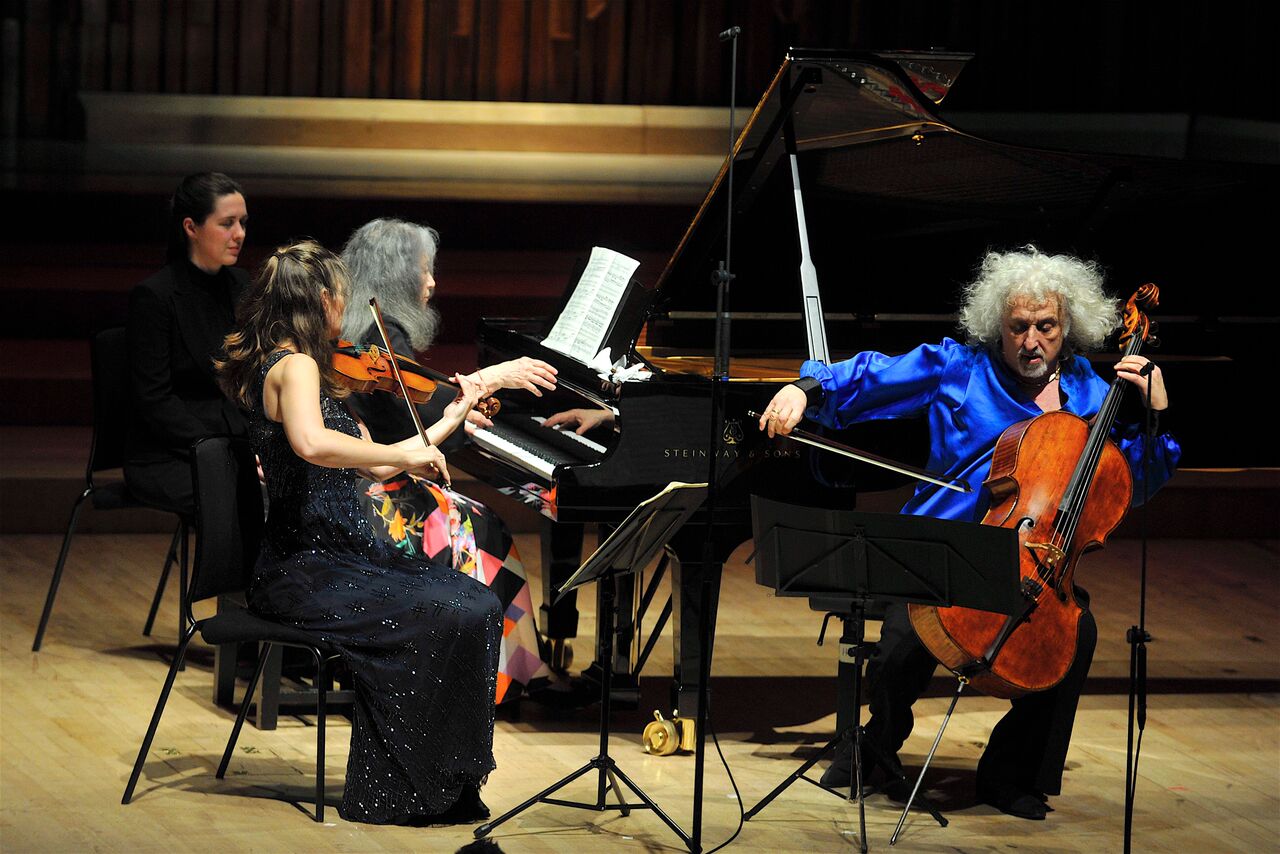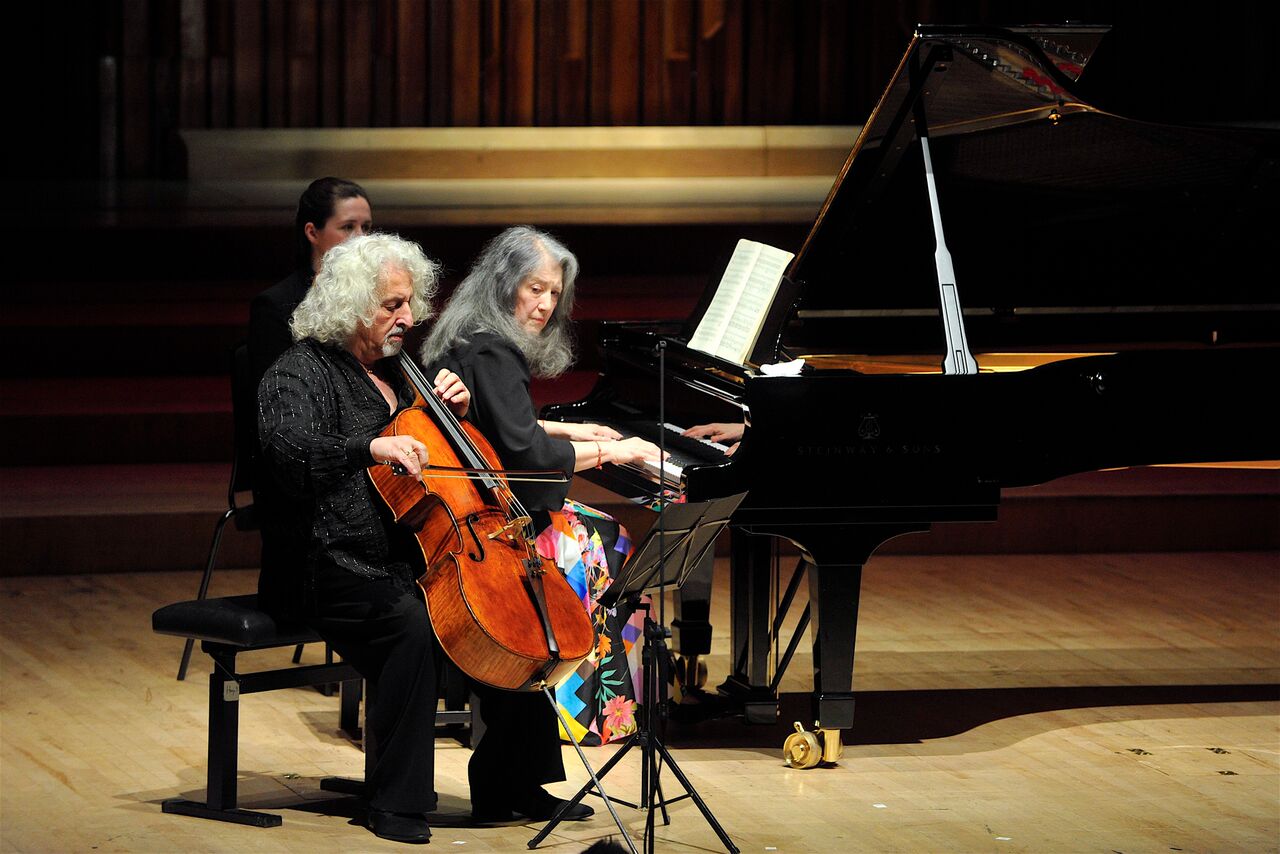Jansen/Maisky/Argerich Trio, Barbican review - three classical titans give chamber music masterclass | reviews, news & interviews
Jansen/Maisky/Argerich Trio, Barbican review - three classical titans give chamber music masterclass
Jansen/Maisky/Argerich Trio, Barbican review - three classical titans give chamber music masterclass
Musical personalities shift but Argerich's generous musicianship remains the constant

They were billed as a Trio, but when the classical super-group of Janine Jansen, Mischa Maisky and Martha Argerich came together at the Barbican last night it was in a sequence of different combinations, each with their own musical identity. The centre of gravity, however, remained constant.
The alchemy of music-making is a funny thing. Decades of friendship and collaboration connect Argerich and Maisky, and yet musically they are completely different beasts. Argerich’s flames burn white-cool and close, while Maisky’s lick and sprawl with profligate, generous heat, sending sparks tumbling each time he draws his bow. It’s a contrast that flourished in Mendelssohn’s impetuous Trio No. 1 in D minor, and found common ground in Shostakovich’s Piano Trio No. 2 in E minor, but which contested the territory of the Beethoven.  The Cello Sonata No. 2 in G minor is a work in the grip of an identity crisis, trying on everything from JC Bach to Mozart to proto-Lisztian excess for size. While Maisky (pictured below with Argerich), responsive to these mercurial moods, whittled down his broad tone right down to a soft classical point for the opening, drawing thicker and harder into the tempestuous Allegro, Argerich had the Romantic drama in her sights from the start, tugging the music forwards in time even a Maisky pulled it back.
The Cello Sonata No. 2 in G minor is a work in the grip of an identity crisis, trying on everything from JC Bach to Mozart to proto-Lisztian excess for size. While Maisky (pictured below with Argerich), responsive to these mercurial moods, whittled down his broad tone right down to a soft classical point for the opening, drawing thicker and harder into the tempestuous Allegro, Argerich had the Romantic drama in her sights from the start, tugging the music forwards in time even a Maisky pulled it back.
The Jansen-Argerich partnership, by contrast, feels like a natural, instinctive kinship. In addition to their astonishing technical facility both share a musical courage of conviction – a willingness to do less, to let the audience hear straight through to the composer without mediation. The apparently unworked directness that results is as exhilarating as it is disarming, and Schumann's A minor sonata unfolded in a single, unbroken thought, led by Jansen’s sweet-strong violin.
It’s hard to imagine two more contrasting trios than the exuberant affirmation and celebration of the Mendelssohn and the trauma and rage of the Shostakovich. The Mendelssohn – a thrilling closer – saw Argerich step forward to set the pace, laying a frenetic musical paper trail in the Scherzo for violin and cello to follow – its bustling, characterful quality a world away from the opaque clarity and control of the passagework in both the outer movements, semiquavers scattered like diamonds, catching the eye beneath the heavy velvet of Maisky and Jansen.  But it was the Shostakovich that haunts. The icy cello harmonics and resigned, canonic tread of the opening can set it up for numbed suppression – emotion felt, but buried fathoms deep. Here, in the defiant urgency of the dances, the manipulation of intonation as a colour, the insistence on individual voice and identity from Jansen and Maisky, we had something else.
But it was the Shostakovich that haunts. The icy cello harmonics and resigned, canonic tread of the opening can set it up for numbed suppression – emotion felt, but buried fathoms deep. Here, in the defiant urgency of the dances, the manipulation of intonation as a colour, the insistence on individual voice and identity from Jansen and Maisky, we had something else.
Music here might lose its fight for life – sound subsiding into not just harmonics but pizzicato shards and finally col legno husk – but there’s a wonderful tension that comes from a performance that won’t accept that, that refuses to go gently. It’s hope, not horror, that gets you in the end, as Argerich, Maisky and Jansen, dogged in their search of resolution, redemption, understood so completely.
rating
Explore topics
Share this article
The future of Arts Journalism
You can stop theartsdesk.com closing!
We urgently need financing to survive. Our fundraising drive has thus far raised £49,000 but we need to reach £100,000 or we will be forced to close. Please contribute here: https://gofund.me/c3f6033d
And if you can forward this information to anyone who might assist, we’d be grateful.

Subscribe to theartsdesk.com
Thank you for continuing to read our work on theartsdesk.com. For unlimited access to every article in its entirety, including our archive of more than 15,000 pieces, we're asking for £5 per month or £40 per year. We feel it's a very good deal, and hope you do too.
To take a subscription now simply click here.
And if you're looking for that extra gift for a friend or family member, why not treat them to a theartsdesk.com gift subscription?
more Classical music
 Bizet in 150th anniversary year: rich and rare French offerings from Palazzetto Bru Zane
Specialists in French romantic music unveil a treasure trove both live and on disc
Bizet in 150th anniversary year: rich and rare French offerings from Palazzetto Bru Zane
Specialists in French romantic music unveil a treasure trove both live and on disc
 Scottish Chamber Orchestra, Ibragimova, Queen’s Hall, Edinburgh review - rarities, novelties and drumrolls
A pity the SCO didn't pick a better showcase for a shining guest artist
Scottish Chamber Orchestra, Ibragimova, Queen’s Hall, Edinburgh review - rarities, novelties and drumrolls
A pity the SCO didn't pick a better showcase for a shining guest artist
 Kilsby, Parkes, Sinfonia of London, Wilson, Barbican review - string things zing and sing in expert hands
British masterpieces for strings plus other-worldly tenor and horn - and a muscular rarity
Kilsby, Parkes, Sinfonia of London, Wilson, Barbican review - string things zing and sing in expert hands
British masterpieces for strings plus other-worldly tenor and horn - and a muscular rarity
 From Historical to Hip-Hop, Classically Black Music Festival, Kings Place review - a cluster of impressive stars for the future
From quasi-Mozartian elegance to the gritty humour of a kitchen inspection
From Historical to Hip-Hop, Classically Black Music Festival, Kings Place review - a cluster of impressive stars for the future
From quasi-Mozartian elegance to the gritty humour of a kitchen inspection
 Shibe, LSO, Adès, Barbican review - gaudy and glorious new music alongside serene Sibelius
Adès’s passion makes persuasive case for the music he loves, both new and old
Shibe, LSO, Adès, Barbican review - gaudy and glorious new music alongside serene Sibelius
Adès’s passion makes persuasive case for the music he loves, both new and old
 Anja Mittermüller, Richard Fu, Wigmore Hall review - a glorious hall debut
The Austrian mezzo shines - at the age of 22
Anja Mittermüller, Richard Fu, Wigmore Hall review - a glorious hall debut
The Austrian mezzo shines - at the age of 22
 First Person: clarinettist Oliver Pashley on the new horizons of The Hermes Experiment's latest album
Compositions by members of this unusual quartet feature for the first time
First Person: clarinettist Oliver Pashley on the new horizons of The Hermes Experiment's latest album
Compositions by members of this unusual quartet feature for the first time
 Gesualdo Passione, Les Arts Florissants, Amala Dior Company, Barbican review - inspired collaboration excavates the music's humanity
At times it was like watching an anarchic religious procession
Gesualdo Passione, Les Arts Florissants, Amala Dior Company, Barbican review - inspired collaboration excavates the music's humanity
At times it was like watching an anarchic religious procession
 Classical CDs: Camels, concrete and cabaret
An influential American composer's 90th birthday box, plus British piano concertos and a father-and-son duo
Classical CDs: Camels, concrete and cabaret
An influential American composer's 90th birthday box, plus British piano concertos and a father-and-son duo
 Cockerham, Manchester Camerata, Sheen, Martin Harris Centre, Manchester review - re-enacting the dawn of modernism
Two UK premieres added to three miniatures from a seminal event of January 1914
Cockerham, Manchester Camerata, Sheen, Martin Harris Centre, Manchester review - re-enacting the dawn of modernism
Two UK premieres added to three miniatures from a seminal event of January 1914
 Kempf, Brno Philharmonic, Davies, Bridgewater Hall, Manchester review - European tradition meets American jazz
Bouncing Czechs enjoy their Gershwin and Brubeck alongside Janáček and Dvořák
Kempf, Brno Philharmonic, Davies, Bridgewater Hall, Manchester review - European tradition meets American jazz
Bouncing Czechs enjoy their Gershwin and Brubeck alongside Janáček and Dvořák
 Solomon, OAE, Butt, QEH review - daft Biblical whitewashing with great choruses
Even a top soprano and mezzo can’t make this Handel paean wholly convincing
Solomon, OAE, Butt, QEH review - daft Biblical whitewashing with great choruses
Even a top soprano and mezzo can’t make this Handel paean wholly convincing

Add comment